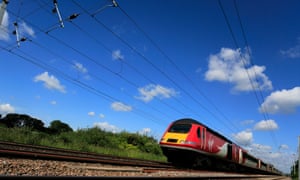
Electric trains are by far the best long distance transport mode when it comes to carbon emissions – at least when their electricity comes from renewable sources like solar or wind.
But the UK’s ageing power network poses a significant challenges to any bid to decarbonise road and rail that relies on the grid. There are now swathes of the British countryside where it is impossible to plug in any new solar, wind or hydropower without being hit with a whopping bill for the full costs of local network reinforcement.
Faced with this constraint, and squeezed by government subsidy cuts, UK solar developers have started to focus on ways to generate power directly for consumption, rather than exporting it to the grid. With the right customers, solar developers can offer lower tariffs than the grid, while still earning more for their power than they would get from exporting it.
Why solar and trains are perfect match
As an industrial client with high on-site daytime energy use and a structural reason to stay put, Network Rail has all of the features needed to support this kind of approach.The UK’s electrified rail routes have all of the features needed to support this kind of PPA-based renewable development, and more. Network Rail is the UK’s single largest electricity consumer, with internal decarbonisation targets and a strong incentive to reduce operational energy costs. Alongside Transport for London (London’s largest electricity consumer), these companies spend around £500m every year on traction power for their trains.
There are already over 5,500km of electrified tracks in the UK, with a major electrification programme building or converting hundreds more over the coming decades.
Early indications suggest it should be possible to connect virtually anywhere on the approximately one-third of this network that uses the direct current (DC) traction power system, unlocking access to thousands of potential new sites that have previously been out of bounds to new renewables.
What’s more, the universe apparently wants this to happen: the standard operating voltage of the third and fourth rail DC routes is 630v-750v, while the standard output voltage of a solar PV array tends to be between 600v and 800v.
This serendipity makes the engineering challenge of connecting the two look very manageable, and the likely cost of the power interface equipment competitive with typical grid connection costs.
Conversion of renewable DC to grid alternating current (AC) results in something like 3% of the electricity being wasted, so supplying DC power direct to trains saves that loss too. Some of these DC routes already suffer from “under-powering”, meaning train operators cannot add more passenger capacity to these routes because the grid cannot supply the extra electricity needed to power the trains. At scale, our innovation could solve this problem as well.
Solar trains in India
While our project has been driven by the UK context, direct connection of solar to railways will be a world first that has far wider potential application. Globally, most city metros around the world run on rail systems at 750V. If connection to AC overhead lines also proves viable through our work, then the market potential goes well beyond city metros.For instance, analysts have identified inadequate distribution and transmission infrastructure as a key obstacle to realising India’s aggressive target of 100GW of solar PV capacity by 2022. But India already has over 25,000km of electrified tracks, and an electrification target of 2,000km of new tracks every year.
If our innovation means India can power its railways directly with trackside solar then we will have made a huge contribution to the global project to keep fossil fuels in the ground.
In the UK, if our feasibility study proves successful, the next step will be to prove the concept with a handful of real-world pilot projects. For this, we’re working with members of the Community Energy South umbrella group of renewable energy co-operatives to identify promising sites where they could install a megawatt or two of trackside solar.
Our vision here is to bring local people, commuters and rail employees together to crowdfund investment in these pioneering projects, sharing the financial rewards of progress in the low carbon transition as widely as possible.
source:https://www.theguardian.com
No comments:
Post a Comment